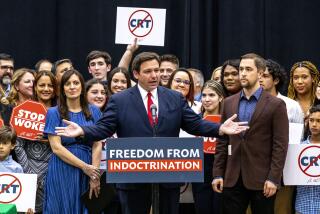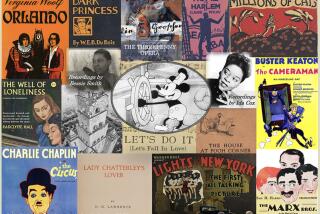Plagiarism Expected to Take a Bigger Byte in the Computer Age : Ethics: Nowadays, so much past work is accessible to be copied. New rules of crediting material may be needed to solve an age-old problem.
- Share via
NEW YORK — “When you steal from one author, it’s plagiarism; if you steal from many, it’s research.” That was the wisdom of Wilson Mizner, a turn-of-the-century dramatist and sometime prospector.
Some 2,000 years earlier, the Roman playwright Terence put it this way: Nullum est iam dictum quod non sit dictum prius, or, “Nothing is said nowadays that has not been said before.”
Which is to say the problem of plagiarism is not new. But it is getting renewed attention nowadays--in part for reasons that neither Mizner nor Terence could have anticipated.
Writers today can easily see what many others have written on a subject by searching databases: vast, computer-stored archives of published material.
Many fields are affected and, lately, the media have been in the hot seat.
“I see enormous amounts of material lifted from other sources,” said Everette Dennis, executive director of the Freedom Forum Media Studies Center at Columbia University, who has been a victim himself.
Dennis says a bad old situation has become slightly worse because the databases allow easy access to vast amounts of material that previously was very difficult to find.
On July 29, the Ft. Worth Star-Telegram columnist fired a columnist for “substantial duplication” of a Washington Post story.
In the same month, scandals over who didn’t get credit rattled Japan’s Kyodo News Service, the Washington Post, the Boston University communication school, the New York Times and a Stanford University lecturer whose book failed to credit excerpts taken from a magazine article.
Roger Zissu, a Manhattan attorney and copyright expert, notes that plagiarism can occur in music, movies, literature, art, academic papers--even who gets credit for computer software programs.
A woman is suing rock musician Lenny Kravitz, claiming that she, not he, wrote most of the lyrics to Madonna’s hit song, “Justify My Love.” Last month, a jury found that the musical theme of television’s “Winds of War” miniseries was stolen from a song written by a history professor; the verdict was being appealed.
Last spring, an esteemed Abraham Lincoln biographer, backed by 22 peers, vehemently denied that he had plagiarized an earlier work and said his own book drew on a “common body of knowledge in the public domain.”
The long list of cases doesn’t include the many legal and moral gray areas of plagiarism--some of which are considered socially acceptable.
“There’s not a very clear definition in most people’s minds what constitutes plagiarism,” Dennis said.
“President Bush takes credit for things that many dozens of people spend time writing. We kind of understand that,” said Arthur Applbaum, assistant professor of public policy at Harvard University. “We know the CEO of a corporation is not going to write every word of an annual report he signs.”
Applbaum said that, under the usual pecking order, a scientific paper might have as many as 100 authors but credit just a few of them. He said that is a system he believes needs revamping.
Occasionally, the plagiarism is more blatant. In 1989, a radiologist won a copyright suit against a former collaborator who “whited out” her name on a medical paper and presented it as entirely his own, Zissu said.
Still, Zissu conceded that two people could coincidentally come up with similar language.
One problem, he noted, is that “the line between facts and expression is very blurry. . . . Facts are not protected by copyright, nor are ideas. The expression is what’s protected: the words, the sequence, the way to dramatize it.”
Sometimes plagiarism is considered morally wrong--but doesn’t violate copyright laws.
“Someone trying to get a Ph.D. may find a wonderful piece written in 1773,” said Zissu. “If he submits it and puts his name to it, nobody can sue him. But he’s a plagiarizer and if they catch him, he is finished.”
At other times, it’s accidental--but no less illegal. In 1981, a New York City judge found that Beatle George Harrison had “subconsciously” plagiarized John Mack’s 1963 hit, “He’s So Fine,” when Harrison wrote “My Sweet Lord.”
And not everyone considers plagiarism always evil.
“The fact is that plagiarism is not only an indispensable part of the trade, it also serves the public well because it disperses information wider and faster,” columnist Russell Baker wrote in The New York Times.
“Most news plagiarism . . . consists of filching story ideas and making a few desperate phone calls to copy important news stories which a single paper may have broken exclusively,” Baker wrote. “We are talking about a job that is done on short deadlines under great pressure.”
Nonetheless, the recent spate of finger-pointing among journalists has made many publications hypersensitive about giving credit for facts and ideas.
In the legal world, Zissu tackles the problem on a personal level: his court papers credit the staff members who worked on them.
Applbaum said that, in many fields, it’s not always clear that work resulted from a team effort. He said the solution may be deceptively simple.
In philosophy or literary criticism it’s important to know who wrote the words, but in biochemistry, he said: “The hard, intellectual work . . . is not writing it up. It’s doing the experiment.”
Whether the author is a rocket scientist or speech writer or grade-school pupil cribbing encyclopedia entries, footnotes often are insufficient “to talk about how we’ve shared ideas and were influenced,” said Applbaum.
Applbaum said scholars and scientists should come up with “more unconventional ways of attributing work.” He suggested, somewhat tongue in cheek, that a research paper contain a paragraph like these:
“I wrote most of this myself but my roommate read it over and suggested I change this word.”
“Well, I co-authored this piece a few years ago and don’t remember how much was mine and how much was his.”
“It was done in my lab, but the truth is, I had nothing to do with it.”
Maybe, said Applbaum, some well-known intellectual could start the ball rolling. “It will shock many people . . . but he might set a new convention.”
Even with the hoped-for changes, Applbaum conceded, “there will always be a danger of exploitation. . . . The junior partner will tend to get short shrift in this allocation of credit--and of blame.”
Associated Press news librarian Susan James contributed to this story.
More to Read
The biggest entertainment stories
Get our big stories about Hollywood, film, television, music, arts, culture and more right in your inbox as soon as they publish.
You may occasionally receive promotional content from the Los Angeles Times.










